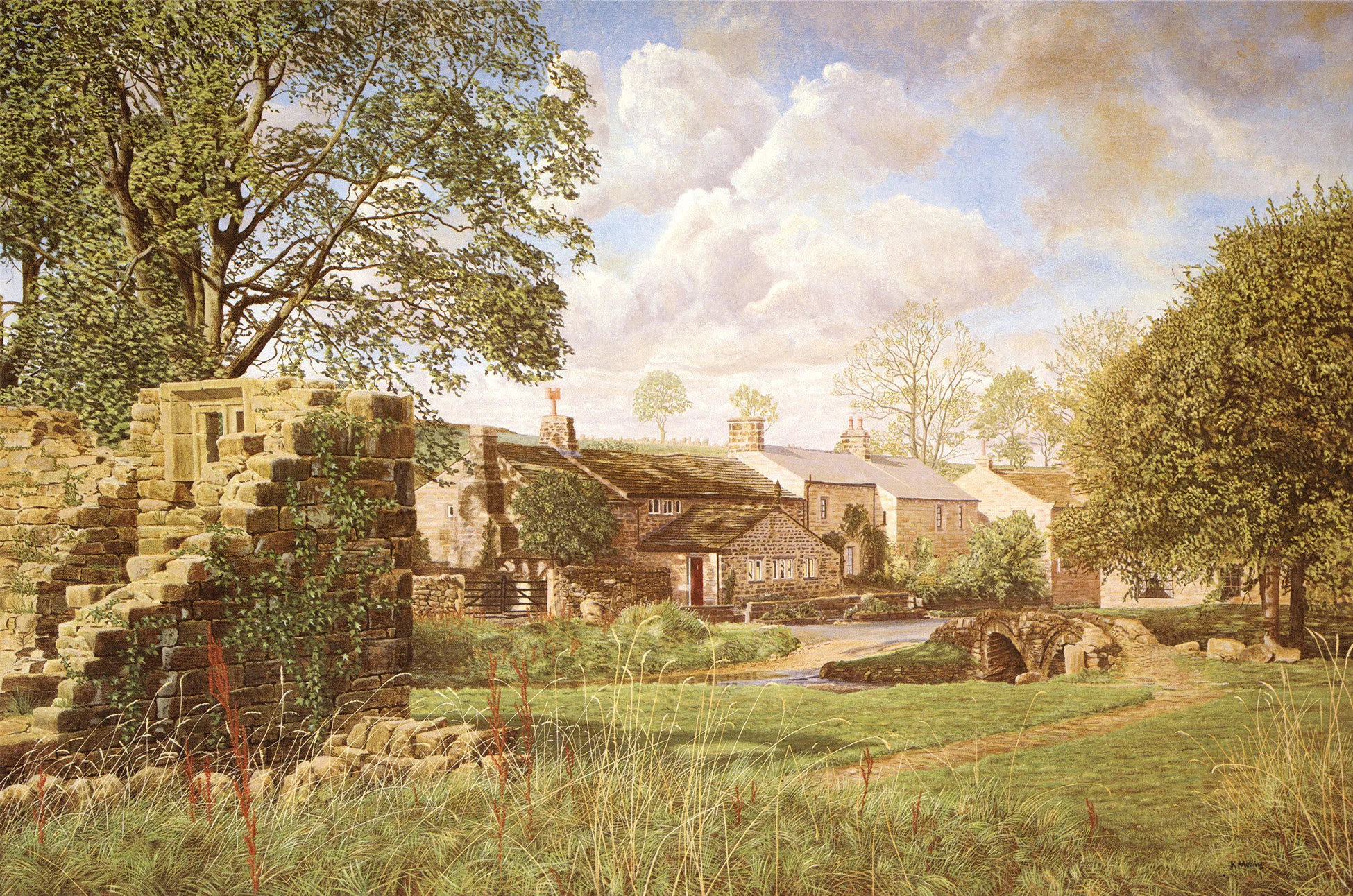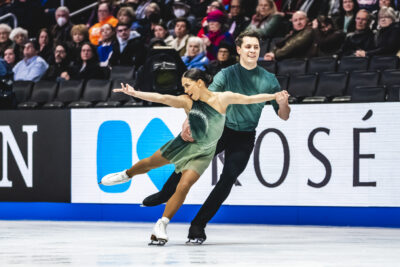
Painting Pendle In All Its Glory
by Andrew Liddle
Northern Life chats to Pendle-based landscape artist Keith Melling.
Perhaps no one has ever painted Pendle more lovingly or captured in such fine detail its many different moods than Keith Melling, arguably England’s finest landscape artist.

Keith Melling
He also happens to be a most accomplished writer on the art of landscape portraiture. A telling passage in his book, An Artist in Pendleside, a magnificent collection of local vistas, sums up his fascination with the ever-changing profile. “Viewed from Colne and Nelson, we see a shapely hill,” he writes, “with sinuous and supple curving lines, not uncommonly described as whale-backed. Seen from Burnley and more so from Accrington, it appears a formidable sprawling mass.”
He marvels at how, somewhere between Blacko and Gisburn, the great mound suddenly metamorphoses into the “shape of a capsized skiff”. When sunset brings a deep red glow, he finds comparisons with the sacred Ayers Rock.

He was born not far away in Colne, a year after the end of WW2, and lives and works in the small village of Fence at the foot of the bewitching hill that falls short of being a mountain. “The immediate landscape outside my door is the handiest for me to paint,” he begins, considering the 50-odd different viewpoints from which he’s captured it.
“But this is not a matter of convenience but because this wonderful scenery compares favourably with any in the land.” As far as he can remember, he made his first drawings of Pendle Hill in 1966, from Stang Top above Roughlee, and has been painting it ever since. “For an artist, its glories are infinite.”
“This wonderful scenery compares favourably with any in the land.”
Suppose proof were needed of the longheld classical belief. In that case, artists are born, not made, and creative talent will always find a way to express itself – taking inspiration from whatever is to hand, regardless of setbacks along the way – it is undoubtedly Keith. His early years were a constant battle to realise his talent.
“I’m from a working-class family,” he reveals. “There were no pictures on the walls and no books, only a ready-reckoner and Rupert annuals I received for Christmas.” He loved those tales of Rupert Bear, their gentle, colourful illustrations of the idyllic English village of Nutwood. “I also really liked those Charles Tunnicliffe bird portraits on cards in packets of PG Tips tea.”

Pendle Hill from Pasture Lane
He doesn’t know when the artistic talent first manifested itself. “I’ve always painted,” he says thoughtfully, “or so it seems.” His teachers at Primet School, Colne, certainly recognised his exceptional ability when he started to recreate Tunnicliffe’s birds from memory.
His secondary education ended a month after his fifteenth birthday when he left with little or no idea about future prospects. “I always wanted to be an artist, from being 7 or 8, but my parents said you can’t make a living. That’s not for a working-class lad.”
“I always wanted to be an artist, from being seven or eight, but my parents said you can’t make a living from that.”
He took the first job he could find in an engineering firm, where he toiled from 7.30 am until 5.30 pm, attending Nelson and Colne College on a weekly day release. The five-year apprenticeship might have destined him for a career in engineering had he not been born for other things. “I have never thought of myself as having an exceptional talent for art,” this most modest of men says. “It’s a matter of being interested, enthusiastic and practising a lot.”
At age 18, he had a well-received exhibition of 40 oil paintings at Burnley Library. “I wanted to go and study art, but my parents said I must finish my apprenticeship because they’ll always want engineers.” Two years later, he took his first steps towards his true calling when returning to his old college, this time to study art. “They let me in with my engineering qualifications,” he laughs. “I can’t say I learned anything new, but meeting like-minded people was a good experience – and very competitive.”

Wycoller
He next tried his hand at Ceramics at Burnley Art School, which led to him in later life becoming a very accomplished potter, making sculptures and attractive domestic ware. “In fact, I toyed with having that as my first career choice at one point,” he says, “but looking back, it could only have been secondary to painting.”
Eventually, Keith did a degree in Graphic Art at Harris College, Preston. “I didn’t want to be a graphic artist,” he remembers, “so I worked as a labourer in a local mill. Although I was there for about seven years, as far as I was concerned, it was only temporary until I could do what I wanted, which was paint.”
It was repeatedly winning a local art competition, ‘Pendle in Paint’, that gave him the confidence, in 1981, to turn professional. “I suppose I still had my parents’ mentality about earning a living even though I found I was making more from selling prints than from my job.”
“I found I was making more from selling prints than from my job.”
At last, after many years of struggle, he had found his way – but could never have imagined it would one day lead to a huge following, fan mail pouring in, visitors coming from far afield.
Although Keith uses several different media, including watercolour, gouache and pastel and has even done etchings and wood engravings, he’s renowned for oils. “I’m not sure if I have a favourite because when I’ve been using one medium for a long time, I like to change, and that becomes my favourite for a while.” He gives it further thought. “But if I had to choose, it would probably be oils.” As if in confirmation, he reveals he used to make his own oil paint and still occasionally does. “But, really, it doesn’t matter what I use much because the technique is still the same.”

Downham
Preparation is the key. Before starting the painting, he usually layers on three or four applications of ‘ground’, a base undercoat. Each layer is sanded down before another is applied in traditional methods originally perfected by the Old Masters, whose techniques Keith has studied. Most of what he does, he taught himself.
Much preliminary work lies behind the exquisite naturalistic detail of every painting, as his enormous collection of sketches attests. “I sketch out of habit anywhere I happen to be – on a plane, in the car, at a supermarket, anywhere, even for just a few minutes.”
Many of which have featured in the Pendleside Hospice calendars appearing annually since 2005 – raising £175,000 to date.
Although he has perfected the art of landscape painting, now internationally recognised as one of England’s finest, he is anything but set in his ways. “These days, I work with a mixture of brushes depending on what type of painting it is, and the medium obviously,” he adds. “I don’t use special colours; it’s different each time. I’m currently using indigo oil paint, something I’ve not used since the 1960s. I suppose I used to use ivory or lamp black, but now I mix ultramarine with burned umber or similar for a dark colour. It was the Impressionists who discovered that.”
Some visitors to his studio gallery at Fence tend to assume he is the artist predominantly of Pendleside. He has, however, painted the Lakes and Yorkshire Dales extensively, and many of his finest northern landscapes are collected in books on Yorkshire and Cumbria. Companion volumes to An Artist in Pendleside they are works of art in themselves, beautifully crafted homages to the English countryside.

Thursden Valley
Visiting his online gallery allows the eyes to feast on a magnificent collection of landscapes, many of which have featured in the Pendleside Hospice calendars appearing annually since 2005 – raising £175,000 to date, a tremendous sum.
Holidays take Keith and his wife, June, to many parts of the UK and abroad, and he almost always comes back with a pictorial souvenir painted on the spot. “Yes, I do love the landscape, not just in England,” he says with feeling. “I like any landscape anywhere – especially if it’s dynamic like the Lake District. Above all, I’m drawn to the hills … that’s what I love about the Pendle area.”
Even if we agree that artistic genius such as Keith’s will always manifest itself somehow and somewhere, it’s tempting to think that his long struggle to find its outlet must have been inspired by the indomitable presence of the ‘hill of the witches’. For a young lad living in Colne and Barrowford, Pendle was never far away or out of mind.
NorthernLife Nov/Dec 23




